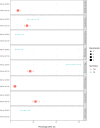Pregnancy and neonatal outcomes in Eastern Democratic Republic of the Congo: a systematic review
- PMID: 39703717
- PMCID: PMC11655456
- DOI: 10.3389/fgwh.2024.1412403
Pregnancy and neonatal outcomes in Eastern Democratic Republic of the Congo: a systematic review
Abstract
Background: Conflict is known to impact maternal and neonatal health in Eastern Democratic Republic of the Congo (DRC), an area of longstanding insecurity. We conducted a systematic review on pregnancy and neonatal outcomes in this region to provide a comprehensive overview of maternal and neonatal outcomes over a 20-year period.
Methods: We systematically searched databases, such as Medline, EMBASE, Global Health, ClinicalTrials.gov and the Cochrane Library, along with grey literature, for articles published between 2001 and 2021. These articles provided quantitative data on selected pregnancy and neonatal outcomes in the provinces of Ituri, Maniema and North and South Kivu, Eastern DRC. We conducted a descriptive analysis, combining results from different data sources and comparing incidence of outcomes in North Kivu with those in other provinces in Eastern DRC.
Results: A total of 1,065 abstracts from peer-reviewed publications and 196 articles from the grey literature were screened, resulting in the inclusion of 14 scientific articles in the review. The most frequently reported pregnancy complications were caesarean sections (11.6%-48.3% of deliveries) and miscarriage (1.2%-30.0% of deliveries). The most common neonatal outcomes were low birth weight (3.8%-21.9% of live births), preterm birth (0.9%-74.0%) and neonatal death (0.2%-43.3%).
Conclusion: Our review provides data on pregnancy and neonatal outcomes in Eastern DRC, which will be valuable for future studies. Despite the area's ongoing armed conflict, the percentages of complications we noted in Eastern DRC are comparable with those observed in other countries in the region.
Systematic review registration: https://www.crd.york.ac.uk/PROSPERO/display_record.php?RecordID=262553, PROSPERO (CRD42021262553).
Keywords: DRC; conflict; eastern; neonatal; outcomes; pregnancy.
© 2024 Kasonia, Brindle, Manno, Edwards, Gardais, Mambula, Mossoko, Choi, Connor, Mukadi, Grais, Keshinro, Roberts, Kavunga-Membo, Bausch, Muyembe and Watson-Jones.
Conflict of interest statement
The authors declare that the research was conducted in the absence of any commercial or financial relationships that could be construed as a potential conflict of interest. RG and CR declare that they were editorial board member of Frontiers, at the time of submission. This had no impact on the peer review process and the final decision.
Figures





References
-
- Namasivayam A, Arcos González P, Castro Delgado R, Chi PC. The effect of armed conflict on the utilization of maternal health services in Uganda: a population-based study. PLoS Curr. (2017) 9:ecurrents.dis.557b987d6519d8c7c96f2006ed3c271a. 10.1371/currents.dis.557b987d6519d8c7c96f2006ed3c271a - DOI - PMC - PubMed
-
- James M. Humanitarian shapeshifting: navigation, brokerage and access in eastern DR Congo. J Interv Statebuild. (2022) 16:349–67. 10.1080/17502977.2021.2002591 - DOI
Publication types
Grants and funding
LinkOut - more resources
Full Text Sources

